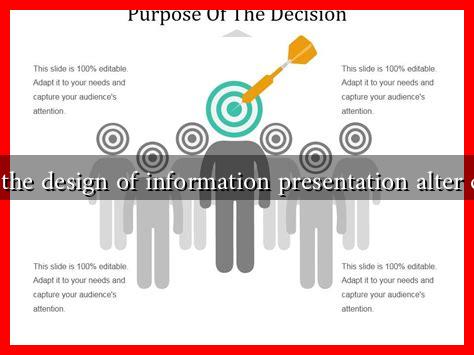-
Table of Contents
- How Can the Design of Information Presentation Alter Decisions?
- The Psychology of Information Design
- Case Studies in Information Design
- 1. Healthcare Decision-Making
- 2. Marketing and Consumer Behavior
- The Role of Data Visualization
- Statistics That Speak Volumes
- Conclusion: The Power of Design in Decision-Making
How Can the Design of Information Presentation Alter Decisions?
In an age where information is abundant and attention spans are dwindling, the design of information presentation plays a crucial role in influencing decisions. Whether in marketing, healthcare, or education, the way information is structured and displayed can significantly impact how individuals interpret data and make choices. This article explores the various ways in which information design can alter decisions, supported by examples, case studies, and relevant statistics.
The Psychology of Information Design
Understanding the psychological principles behind information design is essential for effective communication. Cognitive load theory suggests that individuals have a limited capacity for processing information. When information is presented in a cluttered or complex manner, it can overwhelm the audience, leading to poor decision-making. Conversely, well-structured information can enhance comprehension and retention.
- Clarity: Clear and concise information helps individuals grasp key points quickly.
- Visual Hierarchy: Organizing information in a way that highlights the most important elements can guide decision-making.
- Color Psychology: Colors can evoke emotions and influence perceptions, affecting how information is received.
Case Studies in Information Design
Several case studies illustrate the profound impact of information design on decision-making processes.
1. Healthcare Decision-Making
A study published in the journal Health Affairs examined how visual aids in patient education materials influenced treatment decisions. Patients who received information presented with clear visuals and infographics were more likely to understand their options and make informed choices about their healthcare. The study found that patients exposed to well-designed materials had a 30% higher retention rate of critical information compared to those who received traditional text-heavy documents.
2. Marketing and Consumer Behavior
In the realm of marketing, the design of product packaging can significantly affect consumer choices. A study by Journal of Marketing Research revealed that products with visually appealing packaging were perceived as higher quality, leading to increased sales. For instance, Apple’s minimalist design philosophy not only enhances user experience but also influences consumer perceptions, making their products more desirable.
The Role of Data Visualization
Data visualization is a powerful tool in information design that can transform complex data into easily digestible formats. Effective data visualization can lead to better decision-making by:
- Highlighting Trends: Graphs and charts can reveal patterns that may not be immediately apparent in raw data.
- Facilitating Comparisons: Visual representations allow for quick comparisons between different datasets.
- Engaging the Audience: Interactive visualizations can capture attention and encourage exploration of the data.
For example, the use of dashboards in business intelligence tools enables decision-makers to visualize key performance indicators (KPIs) at a glance, facilitating timely and informed decisions.
Statistics That Speak Volumes
Statistics further underscore the importance of effective information design:
- According to a study by Forbes, 90% of the information transmitted to the brain is visual.
- Research from Nielsen Norman Group indicates that users are 80% more likely to read content that is visually appealing.
Conclusion: The Power of Design in Decision-Making
The design of information presentation is not merely an aesthetic choice; it is a critical factor that can alter decisions across various domains. By leveraging principles of psychology, employing effective data visualization, and learning from case studies, organizations can enhance their communication strategies. As we continue to navigate an information-rich world, understanding the impact of design on decision-making will be essential for success.
In summary, whether in healthcare, marketing, or business intelligence, the way information is presented can significantly influence choices. By prioritizing clarity, visual hierarchy, and engaging design, we can empower individuals to make informed decisions that lead to better outcomes.

